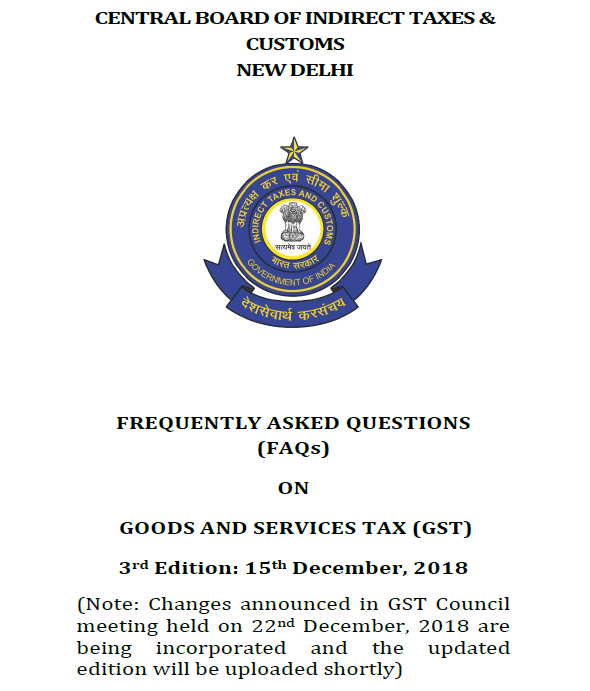FAQs on GST by CBIC – Third Edition
FAQs on GST by CBIC – Third Edition
The compilation of (Frequently Asked Questions) FAQs on GST brought out by the National Academy of Customs, Indirect Taxes & Narcotics (NACIN), the apex training institution under the Central Board of Indirect Taxes and Customs (CBIC), has been extremely well received. The first edition of GST FAQs was released on 21st September 2016 by the Hon’ble Finance Minister. The first edition, released well before the roll-out of GST on 1st July 2017, served to provide a ready reference to tax officials, taxpayers as well as laymen. In order to serve a wider audience, GST FAQs have been translated in several languages and updated from time to time.
The second edition of these FAQs was released on 31.03.2017. A number of significant developments have taken place since the last edition. Accordingly, the third edition of GST FAQs, updated as on 15th December 2018 is being brought out. It contains 25 chapters and more than 1000 questions. More than 450 questions have been added as compared to the last edition. I am sure that these FAQs will be of great help in dissemination of information and in spreading awareness on GST among the tax officials, Trade and public. I congratulate DG NACIN and her team and I am sure that more such publications will be brought out for the benefit of all stakeholders.
(S. Ramesh)
Chairman CBIC
Download the full FAQs on GST by CBIC – Third Edition, by the clicking the below image:

1. Overview of Goods and Services Tax:
Q 1. What is the Goods and Services Tax (GST)?
Ans. It is a destination based tax on consumption of goods and services. It is proposed to be levied at all stages right from manufacture up to final consumption with credit of taxes paid at previous stages available as set off. In a nutshell, only value addition will be taxed and the burden of the tax is to be borne by the final consumer.
Q 2. What exactly is the concept of a destination-based tax on consumption?
Ans. The tax would accrue to the taxing authority which has jurisdiction over the place of consumption which is also termed as the place of supply.
Q 3. Which of the existing taxes are proposed to be subsumed under GST?
Ans. The GST would replace the following taxes:
(i) taxes currently levied and collected by the Centre:
a. Central Excise duty
b. Duties of Excise (Medicinal and Toilet Preparations)
c. Additional Duties of Excise (Goods of Special Importance)
d. Additional Duties of Excise (Textiles and Textile Products)
e. Additional Duties of Customs (commonly known as CVD)
f. Special Additional Duty of Customs (SAD)
g. Service Tax
h. Central Surcharges and Cesses so far as they relate to supply of goods and services
(ii) State taxes that would be subsumed under the GST are:
a. State VAT
b. Central Sales Tax c. Luxury Tax
d. Entry Tax (all forms)
e. Entertainment and Amusement Tax (except when levied by the local bodies) f. Taxes on advertisements g. Purchase Tax
h. Taxes on lotteries, betting and gambling
i. State Surcharges and Cesses so far as they relate to supply of goods and services
The GST Council shall make recommendations to the Union and States on the taxes, cesses and surcharges levied by the Centre, the States and the local bodies which may be subsumed in the GST.
Q 4. What principles were adopted for subsuming the above taxes under GST?
Ans. The various Central, State and Local levies were examined to identify their possibility of being subsumed under GST. While identifying, the following principles were kept in mind:
(i) Taxes or levies to be subsumed should be primarily in the nature of indirect taxes, either on the supply of goods or on the supply of services.
(ii) Taxes or levies to be subsumed should be part of the transaction chain which commences with import/ manufacture/ production of goods or provision of services at one end and the consumption of goods and services at the other.
(iii) The subsumation should result in the free flow of tax credit in intra and inter-State levels. The taxes, levies and fees that are not specifically related to supply of goods & services should not be subsumed under GST.
(iv) Revenue fairness for both the Union and the States individually would need to be attempted.
Q 5. Which are the commodities which have been kept outside the purview of GST?
Ans. Article 366(12A) of the Constitution as amended by 101st Constitutional Amendment Act, 2016 defines the Goods and Services Tax (GST) as a tax on supply of goods or services or both, except supply of alcoholic liquor for human consumption. So alcohol for human consumption is kept out of GST by way of definition of GST in the constitution. Five petroleum products viz. petroleum crude, motor spirit (petrol), high-speed diesel, natural gas, and aviation turbine fuel have temporarily been kept out and GST Council shall decide the date from which they shall be included in GST.
Q 6. What is the status in respect of taxation of above commodities after introduction of GST?
Ans. The existing taxation system (VAT & Central Excise) will continue in respect of the above commodities.
Q 7. What is the status of Tobacco and Tobacco products under the GST regime?
Ans. Tobacco and tobacco products is leviable to GST. In addition, the Centre has the power to levy Central Excise duty on these products.
Q 8. What type of GST is proposed to be implemented?
Ans. It would be a dual GST with the Centre and States simultaneously levying it on a common tax base. The GST to be levied by the Centre on intra-State supply of goods and / or services would be called the Central GST (CGST) and that to be levied by the States/ Union territory would be called the State GST (SGST)/ UTGST. Similarly, Integrated GST (IGST) will be levied and administered by Centre on every inter-state supply of goods and services.
Q 9. Why is Dual GST required?
Ans. India is a federal country where both the Centre and the States have been assigned the powers to levy and collect taxes through appropriate legislation. Both the levels of Government have distinct responsibilities to perform according to the division of powers prescribed in the Constitution for which they need to raise resources. A dual GST will, therefore, be in keeping with the Constitutional requirement of fiscal federalism.
Q 10. Which authority will levy and administer GST?
Ans. Centre will levy and administer CGST & IGST while respective states /UTs will levy and administer SGST/ UTGST.
 ConsultEase Administrator
ConsultEase Administrator
Consultant
Faridabad, India
As a Consultease Administrator, I'm responsible for the smooth administration of our portal. Reach out to me in case you need help.







